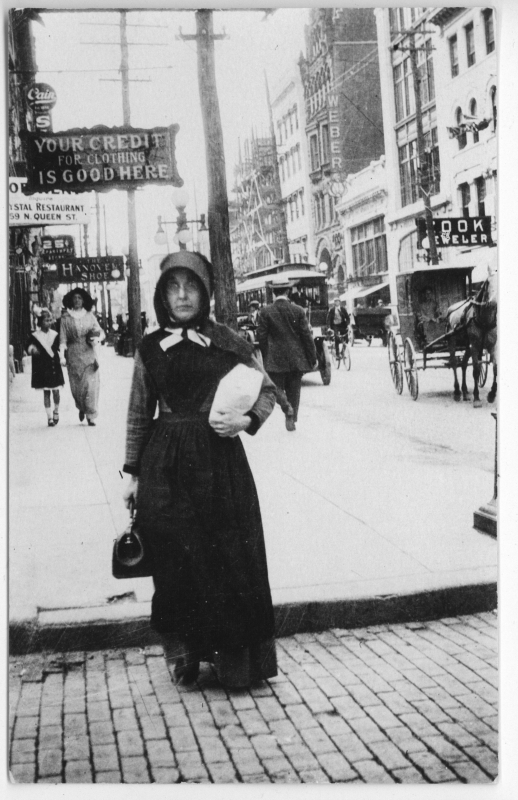We would like to thank Pr. Donald B. Kraybill for his advice and his paper published in French (Modes pratiques n°2). Pr. Donald B. Kraybill taught history ans sociology of Amish in Elizabethtown College (Pennsylvania). He published in particular: The Amish Struggle With Modernity (with Marc Alan Olshan), UPNE, 1994; The Amish (with Karen Johnson-Weiner and Steven Nolt), John Hopkins University Press, 2013 and Renegade Amish: Beard Cutting, Hate Crimes, and the Trial of the Bergholz Amish, John Hopkins University Press, 2014.
Photograph of Amish in a shopping street of Lancaster in front of a clothing store, Pennsylvania, 1900s.
Manuel Charpy
Photograph of Amish in a shopping street of Lancaster in front of a clothing store, Pennsylvania, 1900s.
Manuel Charpy
Amish people are not allowed to photograph, record, and represent themselves by any means. The entire community observes this rule. Any device or technique that could represent the world is forbidden. Posing and depicting oneself is a serious violation, especially for adults. This law is linked with a deep principle of Amish way of life, being humble and devoted to the community. It implies that photography glorifies the individual and, in this context, to everything that could be framed by a camera. There is no place for print memories nor for social representations as a community, a family or an individual, or even for functional uses of photography such as ID photos. This rule touches something deep about photography and its social impact.
As a photographer, this project on clothing in the Amish community wasn’t neutral and, I can add, it wasn’t easy. Photography was banned in 1863. Before that date, there were no restrictions and some Amish families took their portraits in professional photographic studios. I worked with the archives of the Lancaster Mennonite Historical Society to find family portraits of this time. There, I also discovered a large collection of postcards on Amish life, printed since the beginning of the 20th century. This collection consisted mostly of candid photographs taken outdoors from afar, depicting scenes on the street, agricultural work or leisure activities. Interestingly, at the same time that photography was forbidden by the Amish community, the curiosity of ’English people’, as they call outsiders, increased. The Amish became a touristic attraction due to their peculiar lifestyle. To this day, their way of life appears to be the same since the time the first Amish settled in the United States in the 18th century.
For each new technological evolution, the Amish community decides whether it will be allowed or forbidden. For example, electricity, cars, tractors, washing machines, ready-to-wear clothes or the use of the zip fastener are forbidden. This set of rules is named the Ordnung and it regulates the public, private and ceremonial life in the Amish community. The Ordnung strictly defines the style and use of the handmade clothes that are worn by the Amish people. They appear very similar to the ones worn by the first Amish present in the United States. The Ordnung determines for example the length and the authorized colors for the dresses, the shape of the apron, and if suspenders can be used or not. Despite that, each local church has its own little specific features, allowing some brighter colors, sneakers or snap fasteners. In some places, only safety pins are permitted.
As stunning as it may sound, close to Strasburg, a small town in Lancaster County, Pennsylvania, an Amish shop is providing to the local community modern textiles like Acrylic, Nylon, Lycra and Spandex, mostly made in China. Maybe it is specific to this area to wear clothes made from materials that have their base in industrial chemistry and worldwide trade. It seems that each Amish community while following the same general rules has formed its own arrangements with modern products and technologies. The Amish distrust photography and its emphasis on appearances, yet, in this particular case, they are not afraid to adapt as long as the appearance fulfills its function.
Amish family cutting tobacco.
Undated, postcard published by J.E. Hess, collection of the Lancaster Mennonite Historical Society, Pennsylvania.
 Dress (Rock), female. Worn from age 5 to marriage with Peblum (Lepplin).
Dress (Rock), female. Worn from age 5 to marriage with Peblum (Lepplin).
Photographed by James R. King for the Pennsylvania Mennonite Heritage magazine, Volume 21, Number 3, July 1998. Collection of the Lancaster Mennonite Historical Society, Pennsylvania.
Boy's Mutze, brown & navy lining with hook-and-eye fastener.
Undated, collection of the Lancaster Mennonite Historical Society, Pennsylvania.











